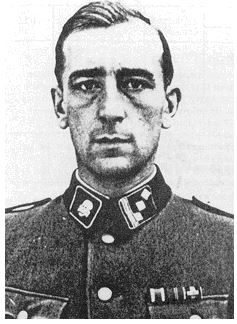Müller, Siegfried (Waffen SS)
- Date of birth:
- October 18th, 1914 (Krefeld/Rhineprovince, Germany)
- Date of death:
- April 7th, 1974 (Giessen/Hesse, Germany)
- Service number:
- SS-Nr.: 230.815 // NSDAP-Nr.:
- Nationality:
- German
Biography
01.04.1934: joined the SS
27.10.1935: 1. Kompanie, Pionier-Bataillon 1, Königsberg
18.01.1938: promoted to Leutnant der Reserve, Chef, 3. (mot.) Kompanie, Pionier-Bataillon 1
01.11.1938: transferred in the Waffen SS as SS-Untersturmführer, Zugführer, SS-Totenkopf-Standarte 'Brandenberg'
00.01.1940: promoted to SS-Obersturmführer
00.05.1940: campaign in France
00.04.1941: promoted to SS-Hauptsturmführer
00.06.1941: campaign in Russia - Operation Barbarossa, SS-Hstuf, Chef, 1. Kompanie, SS-Pionier-Bataillon 3, SS-Division 'Totenkopf'
00.10.1942: SS-Hstuf, Führer, SS-Pionier-Bataillon, SS-Division 'Totenkopf' - Demjansk Pocket
00.00.1943: 3. SS-Panzer-Division 'Totenkopf'
00.06.1943: SS-Hstuf, Kdr, SS-Panzer-Pionier-Bataillon 12, 12. SS-Panzergrenadier-Division 'Hitlerjugend'
30.01.1944: promoted to SS-Sturmbannführer
00.06.1944: campaign in Normandy
17.12.1944: SS-Stubaf, Kdr, SS-Panzergrenadier-Regiment 25, 12. SS-Panzergrenadier-Division 'Hitlerjugend' - campaign in the Ardennes, Monschau, Hollerath, Elsenborn Ridge, Krinkelt, Rocherath
Do you have more information about this person? Inform us!
- Period:
- Second World War (1939-1945)
- Rank:
- SS-Obersturmführer (Lieutenant)
- Unit:
- SS-Totenkopf-Standarte 'Brandenberg', SS-VT
- Awarded on:
- May 26th, 1940
- Period:
- Second World War (1939-1945)
- Rank:
- SS-Obersturmführer (Lieutenant)
- Unit:
- SS-Totenkopf-Standarte 'Brandenberg', SS-VT
- Awarded on:
- June 22nd, 1940
- Period:
- Second World War (1939-1945)
- Rank:
- SS-Hauptsturmführer (Captain)
- Awarded on:
- July 21st, 1942
- Period:
- Second World War (1939-1945)
- Rank:
- SS-Hauptsturmführer (Captain)
- Unit:
- Fûhrer, SS-Totenkopf-Pionier-Bataillon, SS-Division "Totenkopf", Waffen-SS
- Awarded on:
- October 9th, 1942
- Period:
- Second World War (1939-1945)
- Rank:
- SS-Hauptsturmführer (Captain)
- Awarded on:
- December 22nd, 1942
Bronze version.
- Period:
- Second World War (1939-1945)
- Awarded on:
- 1943
- Period:
- Second World War (1939-1945)
- Awarded on:
- 1944
- Period:
- Second World War (1939-1945)
- Awarded on:
- 1944
- Period:
- Second World War (1939-1945)
- Rank:
- SS-Sturmbannführer (Major)
- Awarded on:
- October 9th, 1944
- Period:
- Second World War (1939-1945)
- Rank:
- SS-Sturmbannführer (Major)
- Unit:
- Kdr, SS-Panzer-Pionier-Bataillon 12, 12. SS-Panzer-Division "Hitlerjugend", Waffen-SS
- Awarded on:
- December 5th, 1944
- Awarded for:
- Operation Epsom
- Period:
- Second World War (1939-1945)
- Rank:
- SS-Sturmbannführer (Major)
- Unit:
- Kommandeur, SS-Panzergrenadier-Regiment 25, 12. SS-Panzer-Division "Hitlerjugend", Waffen-SS
- Awarded on:
- December 19th, 1944
“After the 277. Volksgrenadier-Division failed to force its way through the enemy positions west of Hollerath on the 16.12.1944, the SS-Pz.Gren.Rgt. 25 received orders on the morning of the next day to push past the troops that had gotten bogged down in the attack and force a breakthrough itself towards Krinkelt.
By this time the element of surprise had been lost, and the enemy had inserted the 2nd American Infantry Division into the Rocherath-Krinkelt area. In spite of this though the Regiment nonetheless managed to break through the positions of the 99th American Infantry Division, capture Rocherath (bitterly defended by the 2nd American Infantry Division) and force the enemy to give up Krinkelt. This took place over the course of two days of extremely tough village and forest combat. Over 450 prisoners were brought in. The total of dead and wounded that the enemy left on the battlefield was even higher than this.
This significant success for the wider combat situation is first and foremost attributable to SS-Sturmbannführer Müller, who continued to ensure that the attack stayed in motion throughout the village/forest combat despite the major difficulties encountered with regards to command and control.”
Sources
- Photo 1:
- Photo: Siegfried Müller - KVH West Rokycany
- - PATZWALL, K. & SCHERZER, V., Das Deutsche Kreuz 1941-1945, Verlag Klaus D. Patzwall, Norderstedt, 2001.
- Die Ordensträger der Deutschen Wehrmacht (CD), VMD-Verlag GmbH, Osnabrück, 2002
- 12. SS-Panzerdivision "Hitlerjugend"
- Axis History Forum via Awardholders / unit
- das-ritterkreuz.de














